Astana, now the capital of Kazakhstan, was formerly known as Akmola and later Tselinograd during the Soviet era. In 1997, the capital was moved here from Almaty as part of President Nursultan Nazarbayev’s vision to develop a more centrally located and strategically positioned capital. The following year, the city was renamed Astana, which simply means “capital” in Kazakh. Over the years, it has undergone rapid transformation, evolving from a modest provincial city into a futuristic metropolis with bold, modern architecture. Though briefly renamed Nur-Sultan in 2019 to honor the first president, the city reverted to Astana in 2022. Today, it stands as a symbol of Kazakhstan’s post-Soviet growth and ambition.
Astana was the final stop on our month-long journey through Uzbekistan, Kyrgyzstan, and Kazakhstan. We spent the better part of two days there, walking around extensively in an effort to see as much as possible. In this post, I’ll share my experiences from our stay, along with some recommendations and our walking itinerary, which you might find useful if you’re planning to visit Astana in a similar timeframe.
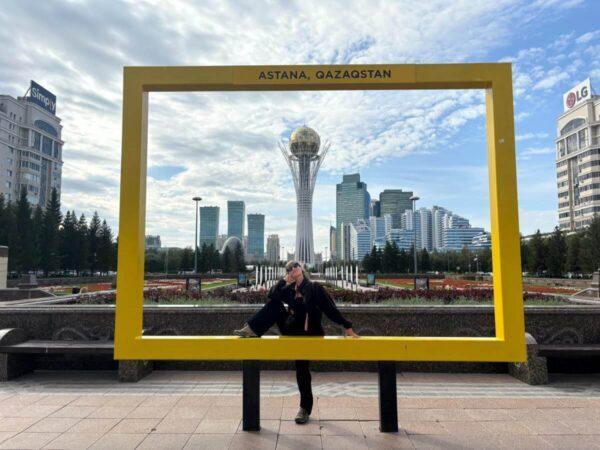
Affiliation disclosure: By purchasing goods or services via the links contained in this post, I may be earning a small commission from the seller's profit, without you being charged any extra penny. You will be thus greatly helping me to maintain and keep enriching this website. Thanks!
We arrived in Astana in the early afternoon in a shared taxi from Karagandy. The driver dropped us off in the south suburbs, near the Palace of Peace and Reconciliation, one of the city’s most distinctive modern landmarks. Designed by British architect Norman Foster, this pyramid-shaped building was completed in 2006 as a symbol of unity and dialogue among different cultures and religions. The structure stands 62 meters tall, with its glass-and-steel facade reflecting the sky, and houses a conference hall, museum, art galleries, and an opera theater. It was built to host the Congress of Leaders of World and Traditional Religions, a global interfaith summit held in Kazakhstan. Inside, the top floor features a brightly lit chamber decorated with stained-glass doves, reinforcing the theme of peace.
We called a Yandex taxi to take us to our hotel in Astana’s northern suburbs.
Where to Stay in Astana
We stayed in Belon Inn, a modest yet comfortable hotel 6 km from downtown. A fine choice with decent rooms and friendly staff if you’re looking for a budget-friendly option in this otherwise expensive (for Central Asian standards) city.
If you seek extra comfort in a more central location, check out Kazzhol Hotel. This mid-budget hotel offers modern rooms, a fitness center, and an on-site restaurant, making it a comfortable choice for both business and leisure travelers. Located near government buildings and major attractions, it provides easy access to the city’s key sights while maintaining a relaxed atmosphere. With its balance of affordability and quality service, Kazzhol Hotel is a solid option for those looking for a bit more convenience and comfort in the heart of Astana.
And if you want to indulge in a luxurious stay, consider The Ritz-Carlton. This five-star hotel offers elegant rooms with floor-to-ceiling windows, a world-class spa, and fine dining with stunning city views. Located in the Talan Towers complex near major landmarks like Baiterek Tower, it provides top-tier service and exclusive amenities, including a sophisticated cocktail bar and personalized concierge assistance. Whether for business or leisure, The Ritz-Carlton delivers a high-end experience in the heart of Kazakhstan’s capital.
Explore more options on the map below:
Stay22 is a handy tool that lets you search for and compare stays and experiences across multiple platforms on the same neat, interactive map. Hover over the listings to see the details. Click on the top-right settings icon to adjust your preferences; switch between hotels, experiences, or restaurants; and activate clever map overlays displaying information like transit lines or concentrations of sights. Click on the Show List button for the listings to appear in a list format. Booking via this map, I will be earning a small cut of the platform's profit without you being charged any extra penny. You will be thus greatly helping me to maintain and keep enriching this website. Thanks!
Day #1: A Stroll along the Embankment of the Ishim River
We spent our first afternoon with the walk along the Embankment of the Ishim River. This is one of the city’s most scenic and lively public spaces, offering a mix of nature, recreation, and urban views. Running along the Ishim River, it features walking and cycling paths, green spaces, and seating areas, making it a favorite spot for both locals and visitors. In summer, the embankment comes alive with street performers, food stalls, and boat rides, while in winter, the frozen river becomes a natural ice-skating and fishing area. The skyline along the river showcases Astana’s blend of futuristic skyscrapers and classical-style buildings, reflecting the city’s rapid transformation.
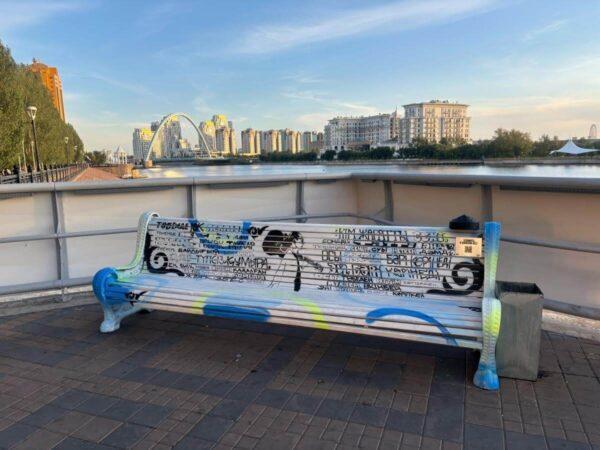
After watching a crimson sunset over the wide river, we grabbed a quick bite at a local restaurant near our place and rested before the long walk ahead tomorrow.
Day #2: All-Day Sightseeing
With the whole day to spare before our evening flight, we embarked on a long self-guided tour of the city, covering roughly 20 km to the center and back. Here are some of the most notable sites we visited, in order.
Astana Park
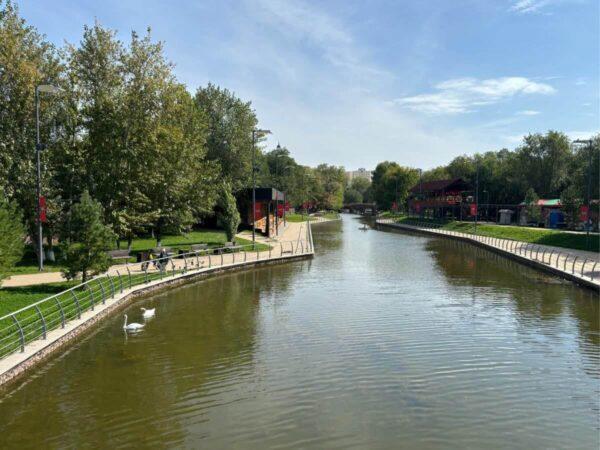
Astana Park is a green oasis in the heart of the city, offering a quiet retreat from the surrounding urban landscape. Featuring tree-lined paths, fountains, and open spaces, the park provides a relaxing spot for walks, picnics, and family outings. While not as large as some of Astana’s newer recreational areas, it has a traditional charm, with older Soviet-era elements blending with modern additions. In warmer months, the park hosts small fairs, street performances, and outdoor activities, making it a lively yet peaceful gathering place. Located near key city landmarks, Astana Park is a convenient and pleasant stop for those looking to take a break from exploring the capital.
Square of State Symbols
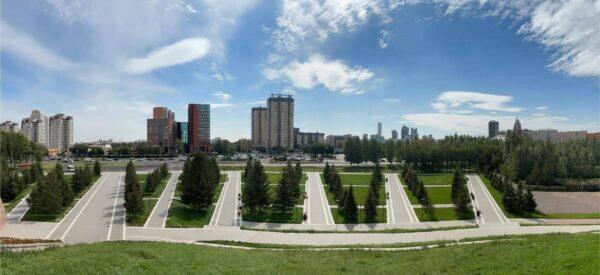
The Square of State Symbols in Astana is a site dedicated to Kazakhstan’s national identity, featuring monuments that represent the country’s sovereignty and history. One of its key highlights is the massive flagpole, standing atop a small hill, where the Kazakh national flag waves prominently over the city. From this elevated spot, you can enjoy a panoramic view of the Astana skyline, with its mix of modern skyscrapers and government buildings. The square also includes sculptures and displays related to national heritage, making it a place of both reflection and impressive city views.
Triumph Astana Residential Complex
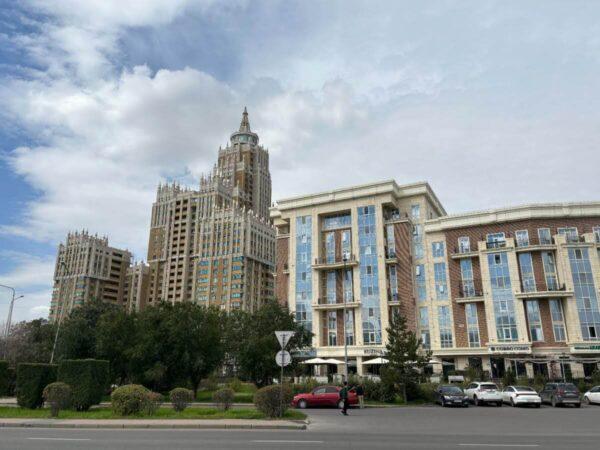
The Triumph Astana Residential Complex is one of Astana’s most visually striking buildings, drawing inspiration from Moscow’s Seven Sisters skyscrapers—a group of iconic Soviet-era high-rises. Its neo-Gothic and Stalinist-inspired design, with towering spires and ornate detailing, makes it stand out against the city’s more futuristic architecture. Completed in the mid-2000s, the complex is both a residential and commercial space, housing apartments (some of which are available for short-term rental), offices, and retail areas. Its grand, symmetrical structure gives it a sense of historical weight, even though it is a relatively modern addition to the skyline.
Nur Astana Mosque
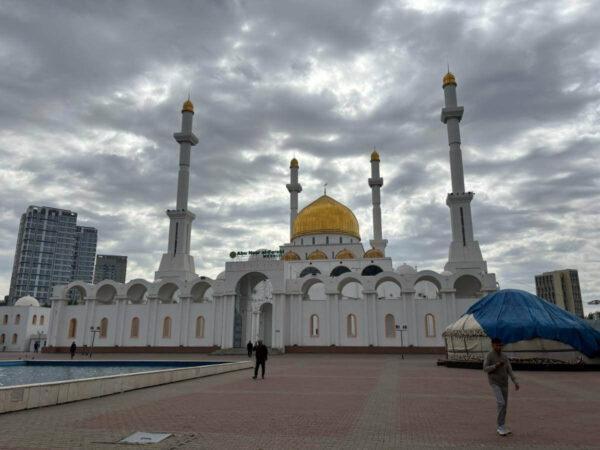
The Nur Astana Mosque is one of the most prominent religious landmarks in Astana, known for its elegant design and symbolic significance. Completed in 2008, it was a gift from Qatar and reflects a blend of traditional Islamic and modern architectural elements. The mosque features a golden dome, four slender minarets (each 63 meters tall), and intricate geometric patterns, creating a striking contrast against the city’s futuristic skyline. Designed to accommodate up to 5,000 worshippers, it serves as an important place of prayer and community gathering. As one of the largest mosques in Kazakhstan, Nur Astana stands as a symbol of the country’s cultural and religious heritage, offering both spiritual and architectural appeal to visitors.
Khan Shatyr Mall
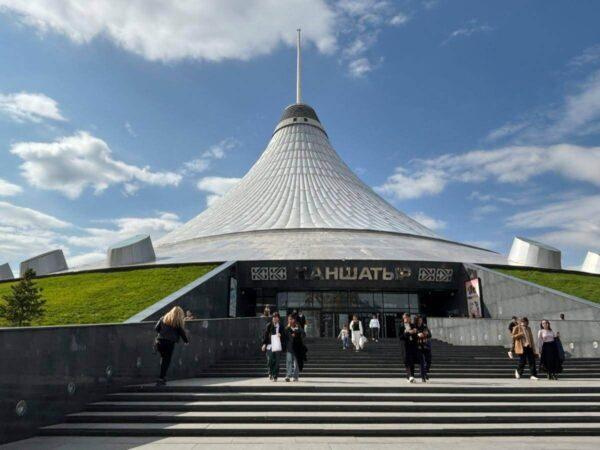
The Khan Shatyr Mall is one of the city’s most distinctive architectural landmarks, designed by renowned British architect Norman Foster. Opened in 2010, this giant transparent tent stands 150 meters tall and covers an area of over 100,000 square meters, making it one of the largest tensile structures in the world. The mall is more than just a shopping center—it houses international retail stores, restaurants, cinemas, and even an indoor beach resort with sand imported from the Maldives. The special ETFE plastic roof regulates the temperature inside, ensuring a comfortable climate year-round despite Astana’s extreme weather. Combining futuristic design with entertainment and leisure, Khan Shatyr is both a shopping destination and a unique architectural attraction in Kazakhstan’s capital.
Lovers Park
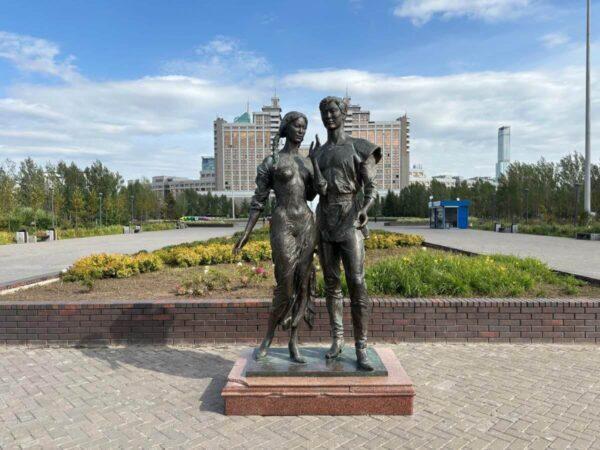
In front of the mall, lies Lovers Park. Designed as a romantic and relaxing green space, the park features scenic walking paths, decorative fountains, flower gardens, and sculptures, including a statue of a young couple symbolizing love and unity. With its open lawns and tree-lined avenues, it’s a popular spot for couples, families, and anyone looking for a quiet break from the city’s modern high-rises. The park also offers beautiful views of the Astana skyline.
Kruglaya Square
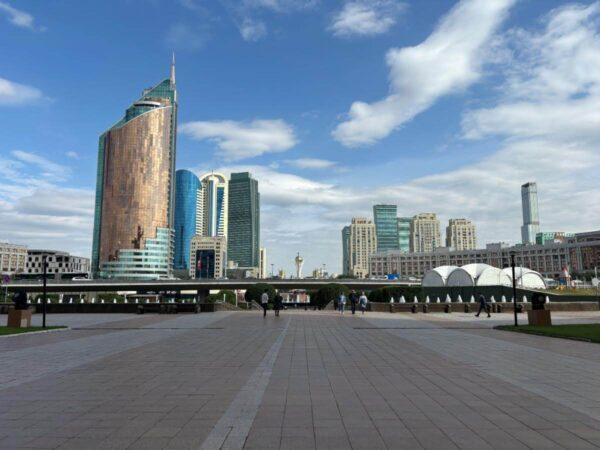
Kruglaya Square is a modern urban space characterized by its circular layout and surrounding contemporary office buildings. Located in the heart of the city, it is bordered by structures like the Transport Tower and the Headquarters of KazMunayGas (Kazakhstan’s state-owned oil and gas company), reflecting Astana’s role as an administrative and business hub. The square itself features fountains, landscaped walkways, and seating areas, making it a popular spot for both professionals and visitors passing through the area. Its open design offers clear sightlines to the city’s skyline, blending functionality with a sense of space in an otherwise dense urban environment. Though not a major tourist attraction, Kruglaya Square serves as a key focal point in Astana’s cityscape.
Nurzhold Boulevard
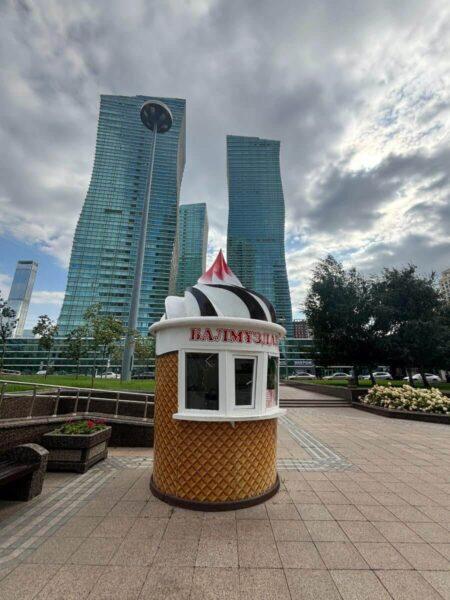
Nurzhol Boulevard is a central pedestrian avenue in Astana, stretching from the Aqorda Presidential Palace to the iconic Kruglaya Square. Designed as the city’s main axis, it is lined with modern government buildings, business centers, and cultural landmarks, reflecting Astana’s planned urban development. The boulevard features wide walkways, fountains, sculptures, and green spaces, making it a popular area for walking and sightseeing. Notable buildings along the route include the Supreme Court of Kazakhstan and the Singing Fountain, a popular gathering spot. With its mix of futuristic architecture and open public spaces, Nurzhol Boulevard offers a dynamic perspective on the capital’s rapid transformation.
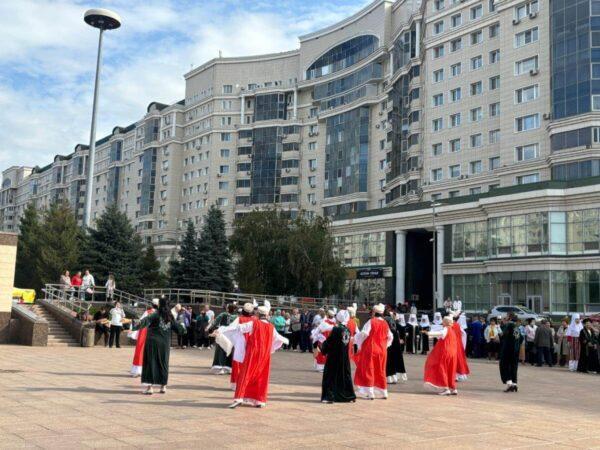
Amid this ultra-modern cityscape, we came across a group performing traditional Kazakh music and dances, creating an intriguing contrast. We also had lunch in this modern, cozy café known for its New York-inspired atmosphere, specialty coffee, and relaxed vibe, located at the western end of Nurzhol Boulevard.
Baiterek Tower
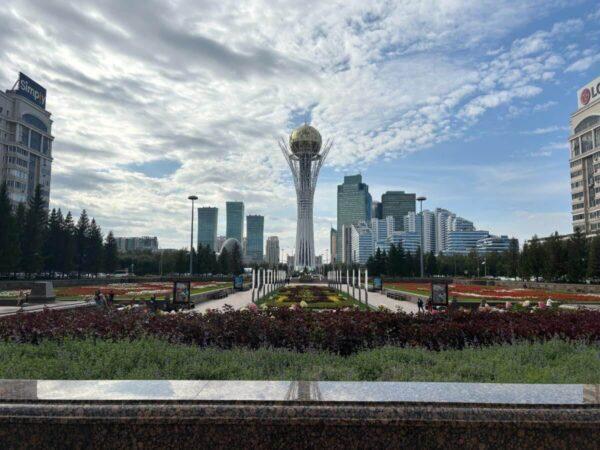
Baiterek Tower is one of Astana’s most recognizable landmarks, symbolizing Kazakhstan’s independence and future aspirations. Standing 97 meters tall, it represents the year 1997, when the capital was moved from Almaty to Astana. The tower’s design is inspired by a Kazakh legend about a mythical tree holding a golden egg, which is reflected in the large golden sphere at its top. Visitors can take an elevator to the observation deck inside the sphere, offering panoramic views of the city skyline, including the Aqorda Presidential Palace and Nurzhol Boulevard. A key highlight inside is a golden handprint of former President Nursultan Nazarbayev, which visitors traditionally place their hand in while making a wish. Since we only had one full day in the city, we had to settle for seeing the tower from below.
Ak Orda Presidential Palace
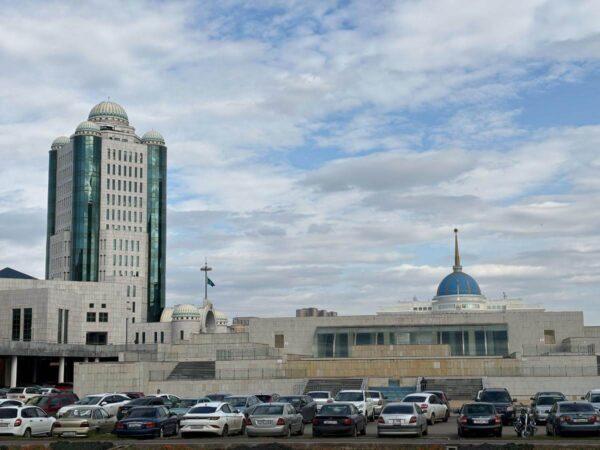
The Ak Orda Presidential Palace is the official residence of the President of Kazakhstan, located at the eastern end of Nurzhol Boulevard in Astana. Completed in 2004, the palace features a grand neoclassical design with a striking blue-and-gold dome, symbolizing Kazakhstan’s sovereignty. Its presidential office, reception halls, and government meeting rooms are housed within a structure that blends European, Kazakh, and modern architectural influences. We only managed to catch a distant glimpse of its dome, as the premises were off-limits within a half-kilometer radius.
Qaraötkel Bridge
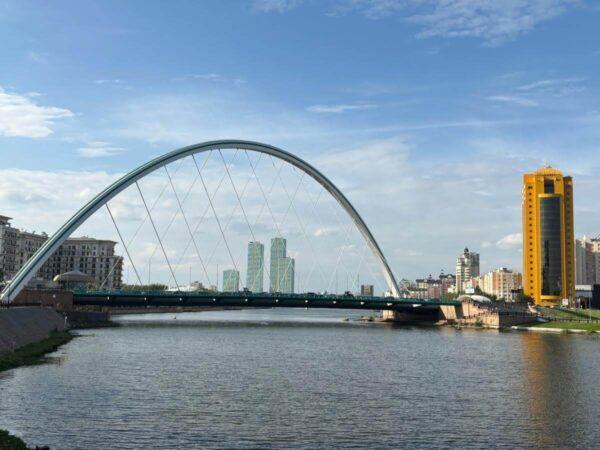
Heading back to the northern districts toward our hotel, we went past Qaraötkel Bridge, a key crossing over the Ishim River. Named after the historical Qaraötkel settlement, which existed in this area before Astana’s expansion, the bridge holds both functional and symbolic significance. Its modern design, featuring elegant arches and decorative lighting, makes it a recognizable part of the city’s skyline, especially at night when it is illuminated. The bridge offers pedestrian walkways alongside vehicle lanes, making it a scenic route for those walking along the Embankment of the Ishim River.
Atyrau Bridge
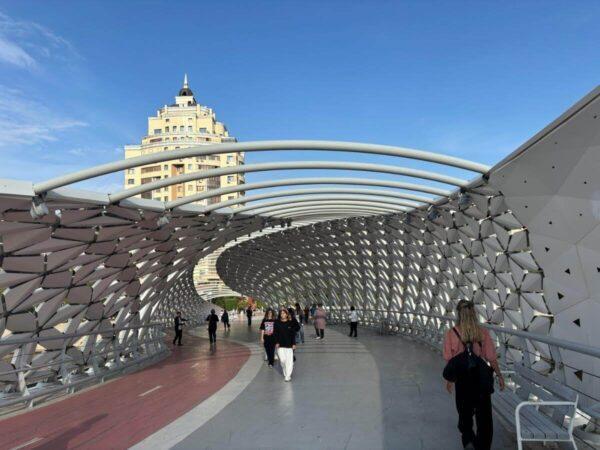
Instead of crossing Qaraötkel Bridge, we continued along the southern bank and crossed the river over Atyrau Bridge. This is a distinctive pedestrian bridge known for its futuristic wave-like design inspired by the movement of water. Opened in 2018, it was named after the city of Atyrau, a major oil hub in western Kazakhstan. Designed to be more than just a crossing, it features seating areas and scenic viewpoints, offering pedestrians a place to pause and enjoy the riverfront.
Activities in Kazakhstan
Photos
View (and if you want use) all my photographs from Astana in higher resolution.
